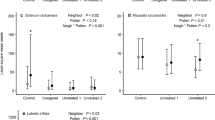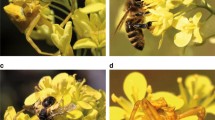Abstract
Plant interactions with mutualists and antagonists vary remarkably across space, and have played key roles in the ecology and evolution of flowering plants. One dominant form of spatial variation is human modification of the landscape, including urbanization and suburbanization. Our goal was to assess how suburbanization affected plant–animal interactions in Gelsemium sempervirens in the southeastern United States, including interactions with mutualists (pollination) and antagonists (nectar robbing and florivory). Based on differences in plant–animal interactions measured in multiple replicate sites, we then developed predictions for how these differences would affect patterns of natural selection, and we explored the patterns using measurements of floral and defensive traits in the field and in a common garden. We found that Gelsemium growing in suburban sites experienced more robbing and florivory as well as more heterospecific but not conspecific pollen transfer. Floral traits, particularly corolla length and width, influenced the susceptibility of plants to particular interactors. Observational data of floral traits measured in the field and in a common garden provided some supporting but also some conflicting evidence for the hypothesis that floral traits evolved in response to differences in species interactions in suburban vs. wild sites. However, the degree to which plants can respond to any one interactor may be constrained by correlations among floral morphological traits. Taken together, consideration of the broader geographic context in which organisms interact, in both suburban and wild areas, is fundamental to our understanding of the forces that shape contemporary plant–animal interactions and selection pressures in native species.



Similar content being viewed by others
References
Adler LS (2008) Selection by pollinators and herbivores on attraction and defense. In: Tilmon KJ (ed) Specialization, speciation, and radiation: the evolutionary biology of herbivorous insects. University of California Press, Berkeley, pp 162–173
Adler LS, Irwin RE (2005) Ecological costs and benefits of defenses in nectar. Ecology 86:2968–2978
Adler LS, Irwin RE (2012) Nectar alkaloids decrease pollination and reproduction in a native plant. Oecologia 168:1033–1041
Badyaev AV, Young RL, Oh KP, Addison C (2008) Evolution on a local scale: developmental, functional, and genetic bases of divergence in bill form and associated changes in song structure between adjacent habitats. Evolution 62:1951–1964
Bang C, Faeth SH, Sabo JL (2012) Control of arthropod abundance, richness, and composition in a heterogeneous desert city. Ecol Monogr 82:85–100
Bolker BM et al (2009) Generalized linear mixed models: a practical guide for ecology and evolution. Trends Ecol Evol 24:127–135
Bronstein JL (1994) Conditional outcomes in mutualistic interactions. Trends Ecol Evol 9:214–217
Cane JH, Minckley RL, Kervin LJ, Roulston TH, Williams NM (2006) Complex responses within a desert bee guild (Hymenoptera: Apiformes) to urban habitat fragmentation. Ecol Appl 16:632–644
Carper AL (2013) Effects of suburbanization on plant-pollinator interactions. Ph.D. thesis, Dartmouth College, Hanover
Cheptou P-O, Carrue O, Rouifed S, Cantarel A (2008) Rapid evolution of seed dispersal in an urban environment in the weed Crepis sancta. Proc Natl Acad Sci 105:3796–3799
Christie FJ, Hochuli DF (2005) Elevated levels of herbivory in urban landscapes: are declines in tree health more than an edge effect? Ecol Soc 10:10
Cuevas-Reyes P, Gilberti L, Gonzalez-Rodriquez A, Fernandes GW (2013) Patterns of herbivory and fluctuating asymmetry in Solanum lycocarpum St. Hill (Solanaceae) along an urban gradient in Brazil. Ecol Ind 24:557–561
Economic Research Service (2005) Land use, value, and management: major uses of land United States Department of Agriculture, http://www.ers.usda.gov/briefing/landuse/majorlandusechapter.htm
Elliott SE (2009) Subalpine bumble bee foraging distances and densities in relation to flower availability. Environ Entomol 38:748–756
Faeth SH, Warren PS, Shochat E, Marussich WA (2005) Trophic dynamics in urban communities. Bioscience 55:399–407
Farrell BD, Mitter C (1998) The timing of insect-plant diversification: might Tetraopes (Coleoptera: Cerambycidae) and Asclepias (Asclepiadaceae) have co-evolved? Biol J Linn Soc 63:553–577
Fenoglio MS, Salvo A, Estallo EL (2009) Effects of urbanisation on the parasitoid community of a leafminer. Acta Oecol 35:318–326
Gerling D, Velthuis HHW, Hefetz A (1989) Bionomics of the large carpenter bees of the genus Xylocopa. Annu Rev Entomol 34:163–190
Gotelli NJ, Ellison AM (2004) A primer of ecological statistics. Sinauer, Sunderland
Greenleaf SS, Williams NM, Winfree R, Kremen C (2007) Bee foraging ranges and their relationship to body size. Oecologia 153:589–596
Halfwerk W et al (2011) Low-frequency songs lose their potency in noisy urban conditions. Proc Natl Acad Sci 35:14549–14554
Hansen AJ et al (2005) Effects of exurban development on biodiversity: patterns, mechanisms, and research needs. Ecol Appl 15:1893–1905
Hennig EI, Ghazoul J (2011) Plant–pollinator interactions within the urban environment. Perspect Plant Ecol Evol Syst 13:137–150
Hope D et al (2003) Socioeconomics drive urban plant diversity. Proc Natl Acad Sci 100:8788–8792
Irwin RE, Adler LS (2006) Correlations among traits associated with herbivore resistance and pollination: implications for pollination and nectar robbing in a distylous plant. Am J Bot 93:64–72
Irwin RE, Brody AK, Waser NM (2001) The impact of floral larceny on individuals, populations, and communities. Oecologia 129:161–168
Irwin RE, Adler LS, Brody AK (2004) The dual role of floral traits: pollinator attraction and plant defense. Ecology 85:1503–1511
Irwin RE, Bronstein JL, Manson JS, Richardson L (2010) Nectar robbing: ecological and evolutionary perspectives. Annu Rev Ecol Evol Syst 41:271–292
Jha S, Kremen C (2013) Resource diversity and landscape-level homogeneity drive native bee foraging. Proc Natl Acad Sci 110:555–558
Kearns CA, Inouye DW (1993) Techniques for pollination biologists. University Press of Colorado, Niwot
Kessler D, Gase K, Baldwin IT (2008) Field experiments with transformed plants reveal the sense of floral scents. Science 321:1200–1202
Kingsbury JM (1964) Poisonous plants of the United States and Canada. Prentice-Hall, Englewood Cliffs
Kotze J, Venn S, Niemela J, Spence J (2011) Effects of urbanization on the ecology and evolution of arthropods. In: Niemela J (ed) Urban ecology: patterns, processes, and applications. Oxford University Press, Oxford, pp 159–166
Leege LM, Wolfe LM (2002) Do floral herbivores respond to variation in flower characteristics in Gelsemium sempervirens (Loganiaceae), a distylous vine? Am J Bot 89:1270–1274
Majerus MEN (1998) Melanism: evolution in action. Oxford University Press, Oxford
Marzluff JM (2001) Worldwide urbanization and its effects on birds. In: Marzluff JM, Bowerman R, Donnelly R (eds) Avian ecology and conservation in an urbanizing world. Kluwer, Boston, pp 19–38
McCall AC, Irwin RE (2006) Florivory: the intersection of pollination and herbivory. Ecol Lett 9:1351–1365
McIntyre NE, Hostetler ME (2001) Effects of urban land use on pollinator (Hymenoptera: Apoidea) communities in a desert metropolis. Basic Appl Ecol 2:209–218
McKinney ML (2002) Urbanization, biodiversity, and conservation. Bioscience 52:883–890
McKinney ML, Lockwood J (1999) Biotic homogenization: a few winners replacing many losers in the next mass extinction. Trends Ecol Evol 14:450–453
Meineke EK, Dunn RR, Sexton JO, Frank SD (2013) Urban warming drives insect pest abundance on street trees. PLoS ONE 8:e59687
Morales CL, Traveset A (2008) Interspecific pollen transfer: magnitude, prevalence and consequences for plant fitness. Crit Rev Plant Sci 27:221–238
Niemelä J (2011) Urban ecology: patterns, processes, and applications. Oxford University Press, Oxford
Ornduff R (1979) Features of pollen flow in Gelsemium sempervirens (Loganiaceae). J Arnold Arboretum 60:377–381
Palumbi SR (2001) Humans as the world’s greatest evolutionary force. Science 293:1786–1790
Pickett STA et al (2001) Urban ecological systems: linking terrestrial ecological, physical, and socioeconomic components of metropolitan areas. Annu Rev Ecol Syst 32:127–157
Potts SG, Vulliamy B, Dafni A, Ne’eman G, Willmer P (2003) Linking bees and flowers: how do floral communities structure pollinator communities? Ecology 84:2628–2642
Potts SG et al (2005) Role of nesting resources in organising diverse bee communities in a Mediterranean landscape. Ecol Entomol 30:78–85
Raupp MJ, Shrewsbury PM, Herms DA (2010) Ecology of herbivorous arthropods in urban landscapes. Annu Rev Entomol 55:19–38
Rodewald AD, Shustack DP, Jones TM (2011) Dynamic selective environments and evolutionary traps in human-dominated landscapes. Ecology 92:1781–1788
Runquist RDB (2012) Pollinator-mediated competition between two congeners, Limnanthes douglasii subsp. rosea and L. alba (Limnanthaceae). Am J Bot 99:1125–1132
Shochat E, Warren PS, Faeth SH, McIntyre NE, Hope D (2006) From patterns to emerging processes in mechanistic urban ecology. Trends Ecol Evol 21:186–191
Stockwell CA, Hendry AP, Kinnison MT (2003) Contemporary evolution meets conservation biology. Trends Ecol Evol 18:94–101
Strauss SY, Armbruster WS (1997) Linking herbivory and pollination—New perspectives on plant and animal ecology and evolution. Ecology 78:1617–1618
Strauss SY, Irwin RE (2004) Ecological and evolutionary consequences of multispecies plant–animal interactions. Annu Rev Ecol Evol Syst 35:435–466
Thompson JN, Cunningham BM (2002) Geographic structure and dynamics of coevolutionary selection. Nature 417:735–738
US-EPA (2006) Raleigh-Durham urban land use indicators 1975–2000 report. http://www.epa.gov/urban/rdu/indicators.htm. Accessed 6 June 2007
Warren PS, Harlan S, Boone C, Lerman SB, Shochat E, Kinzig AP (2010) Urban ecology and human social organization. In: Gaston K (ed) Urban ecology. Cambridge University Press, UK
Wear DN, Greis JG (2004) The southern forest resource assessment: what we learned. Gen Tech Rep SRS-75. USDA, Forest Service, Southern Research Station, Asheville
Winfree R, Griswold T, Kremen C (2007) Effect of human disturbance on bee communities in a forested ecosystem. Conserv Biol 21:213–223
Winfree R, Aguilar R, Vazquez DP, LeBuhn G, Aizen MA (2009) A meta-analysis of bees’ responses to anthropogenic disturbance. Ecology 90:2068–2076
Acknowledgments
We thank J. Andicoechea, J. Benning, L. diBiccari, J. Post, L. Rolfe, and J. Stevens for help in the field, lab, and/or greenhouse, T. Barry and K. DeLong for help with the greenhouse Gelsemium, R. and B. Warren for providing housing during field research, and J. Andicoechea, L. Richardson, R. Schaeffer, C. Urbanowicz, and two anonymous reviewers for comments on the manuscript. Access to field sites was made possible by cooperation from landowners, homeowners’ associations, and private citizens, the North Carolina Division of Parks and Recreation, the Wake County Department of Parks, Recreation, and Open Space, and North Carolina State University. Research was funded by the National Science Foundation (DEB-0743535/0742923 and DEB-0841862) and a Faculty Research Grant from the Rockefeller Foundation at Dartmouth College. Any opinions, findings, and conclusions or recommendations expressed in this material are those of the authors and do not necessarily reflect the views of the funding sources.
Author information
Authors and Affiliations
Corresponding author
Additional information
Communicated by Jennifer Thaler.
Rights and permissions
About this article
Cite this article
Irwin, R.E., Warren, P.S., Carper, A.L. et al. Plant–animal interactions in suburban environments: implications for floral evolution. Oecologia 174, 803–815 (2014). https://doi.org/10.1007/s00442-013-2797-2
Received:
Accepted:
Published:
Issue Date:
DOI: https://doi.org/10.1007/s00442-013-2797-2




